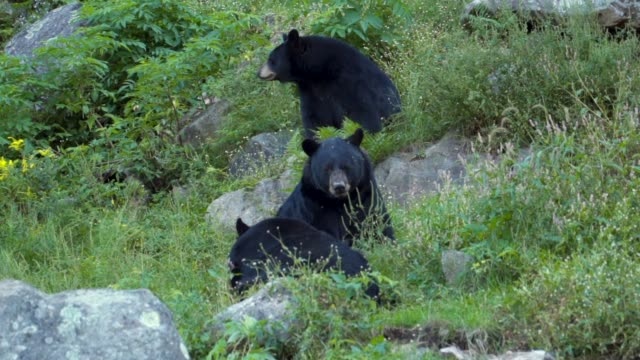SMUGGLER BEARS
CATEGORY: SAILING
PHOTO: BLACK BEARS

“Back in the dear dead days beyond recall” when Old Mother Nature was mixing up the chunky cookie mix that later became the coast of British Columbia, she liked to play in the dough. She happily stuck her fingers in it and made many interesting deep squiggles and gouges, sprials and holes. One of the most playful of her creations was a place that later came to be called Smuggler Cove, a puzzling complexity of steep-sided jigsaw islands amid hide-and-seek waterways with only one tiny entrance connecting it to the Straight of Georgia–and that behind a protective headland. Its name, along with nearby Buccaneer Bay, was indicative of its secretive early users and the appreciation they had for the seclusion and confusion provided by such handy dandy geography.
But this story is not about pirates or smugglers. It is about bears! I’m just trying to paint a little background and throw in a pitch for the theory that the vibratory essence of a place lives on in the rocks, the land, and its wild inhabitants.
At its very end, Smuggler Cove opens into a secluded little–cove! Imagine that! It is like a tiny crater lake with steep, rocky and forested sides and deep, deep water. This was where, one late summer afternoon, we chose to spend the night and sailed in on an early evening tide through its spirals and doglegs. There was one other boat there when we arrived. It was a rarity: a Thunderbird, just like ours. An even greater rarity was two Thunderbirds alone together in the same isolated place. Its master was in the cockpit and we waved to him, but respecting his privacy, along with the provocative thought that the two boats might attempt to breed, we went to the opposite side. Because of the verticality of the shore, it was necessary to fasten a bow line to a lone tree who’s toenails were sunk into solid rock, and drop an anchor off the stern. As soon as we got settled, the other Thunderbirder arrived in his dingy to ask us over to his boat for drinks. We readily accepted his invitation, paddling back across with him side by side, in our respective dinghys. His Thunderbird was secured similarly to ours, but the line was tied into a cleft in the rocks instead of a tree since the shoreline on his side was a jagged twelve foot high rock wall. His boat was quite close in, seemingly in the protective arm of the cliff.
We were sitting in his cockpit enjoying gin and tonics, the men comparing boats (Bob’s number 33 was always a conversation piece, especially because he always kept it looking like new), when, like a flash out of the corner of my eye, I saw a rock falling. My seeing it and its hitting the water were almost simultaneous. It was a big rock–about as big as a wash tub. It landed right off the bow with a tremendous watery crash. We looked up to the top of the cliff from whence it had come and, despite the pitching of the boat, were able to discern three large black bears on the steep slope above the cliff digging in the mossy rocks. Perhaps I only imagined that I also saw a cave-bear-constructed catapult. Almost as fast as the falling of the rock, our new friend leaped to let out his bow line. After that we drank to our survival and the survival of his boat, while we watched the bears exchange rueful glances and head shakes. I assumed they were lamenting their near miss. YES, they WERE TOO shaking their heads!!
I think the bears in that particular place contain the spirits of its long ago inhabitants and, with the help of the sinister terrain, probably sink the boats of modern day impostors as often as they can.
